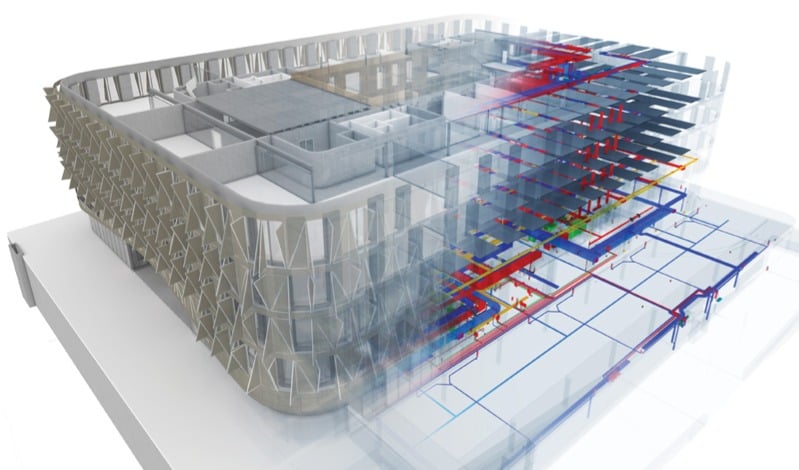Digitalisation is changing the way we live our daily lives. From the way we do our weekly shop, to how we communicate with our friends and colleagues, there is little scope to avoid the fast pace of change! Robbie Blackhurst, Framework Director of Procure Partnerships discusses this impact of Digital construction within the Public Sector.
The construction industry has been criticised in the past for not embracing digital technology to help solve industry-specific challenges. The industry has historically been somewhat slow and hesitant to move away from traditional methods and embrace change. In recent years however, it has been recognised that in order to improve construction outcomes, the industry needs to take charge and utilise the digital technologies available. There is a growing understanding within the industry of how to implement digital technologies to generate real value for all parties in a project team; the momentum for change is gathering.
The implementation of BIM (Building Information Modelling) is the first significant step in creating a digital future for construction. The government has been a fundamental driving force for the widespread use of BIM and in 2016 it made BIM Level 2 a mandatory requirement on all centrally procured public projects. Since then, the uptake of BIM has accelerated and it is increasingly seen as an essential part of the design, construction and asset performance process, helping to achieve optimum productivity and building performance.
BIM is transforming the construction landscape.
In simple terms, BIM is a way of creating a digital representation of a managed physical asset. BIM is a collaborative way of working that promotes early contractor involvement and uses digital technology to unlock more efficient methods of designing, creating and maintaining buildings.
BIM Level 2 requires all project and asset information, documentation and data to be electronic, which supports efficient delivery at the design and construction phases of the project. At the design stage, designers, clients and end users can work together to develop the most suitable design and to test it out on the computer before any construction commences.
A huge benefit of BIM is in the area of information sharing. BIM provides a medium where documentation and detailed, structured information can be stored and maintained in a digital equivalent of the built asset (sometimes referred to as a digital twin). This digital information can be seamlessly transferred between parties, say for example, at handover of the asset, and used for maintenance as the life of the asset evolves. This flow of information prevents parties from working separately (which is where much of the waste in traditional processes comes from!) and offers a more joined up approach. During construction BIM allows the supply chain to efficiently share precise information about components which reduces the risk of errors and interface problems.
Why does the public sector promote the use of BIM?
Today more than ever, the public sector is demanding that the construction industry improves service delivery and demonstrates both value for money and reliability. There is increasing pressure to build more infrastructure, schools and healthcare facilities, and to meet challenging social and affordable housing targets to cater for an ever-growing population.
The increased uptake of BIM is being driven largely by the government mandate, which has been implemented to ensure the public sector can benefit from proven efficiencies throughout the building design, construction and operation phases. BIM has the potential to provide the public sector with transformational benefits, including:
- Improved productivity and efficiency of delivery
- Improved value through reduced costs
- A lower carbon footprint for projects
- Improved collaboration throughout the supply chain to reduce waste
- Improved information sharing throughout the entire lifecycle of the building
- Improved overall quality in the construction works
As a purchaser of construction services and an asset manager, the public sector can make significant savings in capital and operational costs through the use of open, sharable asset information. For the public sector, BIM is not just an important enabling element to achieve the wider construction strategy and pipeline of projects, but is also a useful tool to demonstrate that public facilities meet performance expectations. BIM ensures a readily accessible source of building information for the teams involved in operating, maintaining and adapting completed facilities.
What is the future for digital construction in the public sector and beyond?
Under the Government Construction Strategy 2011-15, the government laid out the requirement for fully collaborative 3D BIM on all centrally procured government construction projects by 2016, and BIM Level 2 was developed to meet this mandate. Once BIM Level 2 maturity has been successfully achieved across all government departments, the 2016 – 2020 construction strategy suggests there will be a gradual move to BIM Level 3, which will enable a fully integrated and collaborative process. With BIM level 3, all disciplines and contributors to a project would be able to access and modify a single, shared project model, removing the risks of conflicting information and supporting the development of whole-life approaches.
The Government recognised the need for a national leadership body to coordinate and drive change and The Centre for Digital Built Britain (CDBB) was announced in the 2017 Autumn budget. The CDBB is a partnership between the Department of Business, Energy & Industrial Strategy and the University of Cambridge and is tasked to transform the UK construction industry through the exploitation of new and emerging technologies, data and analytics which will enhance the built environment.
The CDBB predict that over the next decade, technology such as BIM will combine with the internet of things, advanced data analytics, data driven manufacturing and the digital economy to enable the digitalisation of the entire lifecycle of built assets, dramatically improving the way the public sector delivers its service.
As understanding and maturity increase, BIM will have the power to influence a new generation of construction professionals and the projects they shape in order to change the way project teams collaborate at every stage of the asset lifecycle.
As Mark Farmer warned in his 2016 report for the Construction Leadership Council, ‘Modernise or Die’, it is critical that the industry embraces this technological change to avoid missing the greatest single opportunity to improve productivity and to help offset the current workforce shrinkage. Digital technology is also, after all, an important and essential way to attract a new generation of workers who have grown up in a digital world and who can be that catalyst for change.

Robbie Blackhurst is the Founder and Director of Black Capital Group, the holding company that powers Advance Social Value, Compliance Chain, Procure Partnerships Framework and Strategic Resourcing. Robbie is a member of the Chartered Institute of Builders, is MCIPS certified and has an undergraduate degree in Aviation and Aerospace, a postgraduate degree in Construction Project Management, and a Master’s in Business (MBA).



